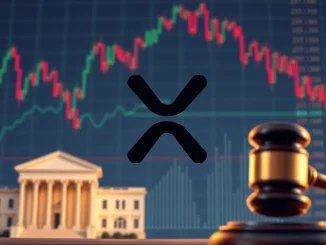
Ever wondered why Robinhood, a platform known for democratizing finance, only lists a select few cryptocurrencies? In a world brimming with thousands of digital assets, Robinhood’s approach might seem surprisingly selective. But as Johann Kerbrat, Robinhood’s VP and General Manager of Crypto, recently revealed, there’s a very deliberate and stringent method to their crypto listing strategy. Let’s dive into the exclusive insights shared at Consensus Hong Kong 2025 and understand why Robinhood prioritizes security and liquidity above all else when it comes to cryptocurrency.
The Cornerstone of Robinhood Crypto Listing: Security and Liquidity
At the heart of Robinhood’s philosophy for crypto listing lies an unwavering commitment to security and liquidity. Kerbrat emphasized that these two factors are not just checkboxes but the fundamental pillars upon which every listing decision is made. Why are these aspects so crucial?
- Security First: In the volatile world of cryptocurrencies, security breaches and vulnerabilities are a constant threat. Robinhood prioritizes the safety of its users’ assets. A rigorous security assessment ensures that any listed cryptocurrency meets the highest standards, protecting users from potential exploits and hacks.
- Liquidity Assurance: Liquidity refers to the ease with which an asset can be bought or sold without causing significant price fluctuations. For a platform like Robinhood, which caters to a broad range of investors, ensuring sufficient cryptocurrency liquidity is paramount. This guarantees that users can seamlessly trade their chosen assets without facing undue slippage or execution issues.
This stringent focus explains why Robinhood currently supports only 22 crypto assets. It’s not about lagging behind in the crypto race; it’s about offering a curated and secure environment for users to engage with digital currencies. This disciplined approach sets Robinhood apart in a market often characterized by rapid and sometimes less-vetted listings.
Navigating the Memecoin Hype vs. Real Crypto Adoption
The cryptocurrency space is no stranger to hype cycles, and memecoins have undeniably captured significant attention. Kerbrat acknowledged the buzz around these digital assets, noting the “significant discussion” they generate. However, he astutely pointed out a critical oversight: the broader, more fundamental adoption of other established cryptocurrencies like Ethereum and Solana.
While memecoins hype can create short-term excitement and trading volume, Robinhood takes a long-term view, focusing on assets that demonstrate genuine technological utility and wider adoption. This perspective doesn’t dismiss memecoins entirely, but it places them within a larger context of the evolving crypto landscape. The emphasis remains on sustainable growth and real-world applications rather than fleeting trends.
The Undeniable Institutional Crypto Demand: Stablecoins and Beyond
Beyond the retail frenzy often associated with cryptocurrencies, Kerbrat highlighted a significant and often underestimated force in the market: institutional crypto demand. He specifically pointed to the strong institutional appetite for stablecoins.
Why are institutions so drawn to stablecoins and other cryptocurrencies?
| Factor | Description |
|---|---|
| Diversification | Institutions are constantly seeking ways to diversify their portfolios. Cryptocurrencies, particularly stablecoins and established blockchains, offer a new asset class with uncorrelated returns to traditional markets. |
| Yield Opportunities | Decentralized finance (DeFi) and other crypto-native platforms offer attractive yield opportunities for stablecoins, often exceeding traditional fixed-income returns. |
| Technological Innovation | Institutions recognize the transformative potential of blockchain technology and cryptocurrencies in various sectors, from finance to supply chain management. Investing in crypto is also an investment in future technological infrastructure. |
| Inflation Hedge | In an environment of rising inflation, some institutions view cryptocurrencies, especially Bitcoin, as a potential hedge against inflationary pressures. |
This institutional interest is not just limited to stablecoins. Established cryptocurrencies like Bitcoin and Ethereum, along with emerging platforms like Solana, are also attracting significant institutional capital. This influx of institutional money further validates the long-term viability and growth potential of the crypto market, moving beyond speculative retail trading.
Beyond the Hype: Focusing on Real Technological Adoption
Kerbrat’s message was clear: it’s crucial to look beyond the temporary spikes of memecoins hype and recognize the ongoing, substantive technological adoption happening within the crypto space. While memecoins might capture headlines, the real story lies in the development and implementation of blockchain technology, the growth of DeFi, and the increasing institutional integration of cryptocurrencies.
What does “real technological adoption” look like in the crypto world?
- Layer-2 Scaling Solutions: Projects like Polygon and Arbitrum are enhancing the scalability and efficiency of Ethereum, making blockchain technology more practical for everyday applications.
- Decentralized Finance (DeFi): DeFi protocols are revolutionizing traditional finance by offering decentralized lending, borrowing, and trading services, increasing financial inclusion and efficiency.
- NFTs and Digital Ownership: Non-Fungible Tokens are expanding beyond digital art to encompass digital identity, supply chain tracking, and intellectual property rights, showcasing the versatility of blockchain technology.
- Enterprise Blockchain Solutions: Major corporations are exploring and implementing blockchain solutions for supply chain management, data security, and improved operational efficiency.
These developments represent tangible progress and demonstrate the real-world utility of blockchain and cryptocurrencies, moving beyond speculative trading towards building a more robust and functional digital economy.
Actionable Insights: What Does Robinhood’s Approach Mean for You?
Robinhood’s rigorous crypto listing process, emphasizing security and liquidity, offers several key takeaways for crypto enthusiasts and investors:
- Quality over Quantity: A smaller selection of cryptocurrencies doesn’t necessarily mean fewer opportunities. It can indicate a focus on quality and reliability, reducing exposure to high-risk, less-vetted assets.
- Prioritize Security: Robinhood’s stance underscores the importance of security in the crypto space. Users should always prioritize platforms and assets that demonstrate a strong commitment to security and risk mitigation.
- Look Beyond the Hype: While memecoins and viral trends can be tempting, long-term success in crypto likely lies in understanding and investing in projects with solid fundamentals, technological innovation, and real-world applications.
- Institutional Validation: The growing institutional interest in cryptocurrencies, particularly stablecoins and established blockchains, signals a maturing market and provides further validation for the long-term potential of digital assets.
Conclusion: A Secure and Sustainable Crypto Future
Robinhood’s commitment to a strict crypto listing process, centered on security and liquidity, reflects a responsible and forward-thinking approach to the cryptocurrency market. By prioritizing these core principles and looking beyond fleeting trends, Robinhood is contributing to a more secure and sustainable crypto ecosystem. As the crypto landscape continues to evolve, this focus on fundamental values and real technological adoption will be crucial for fostering long-term growth and trust in the digital asset space. The message is clear: in the world of crypto, security, liquidity, and genuine utility are not just important – they are paramount.



